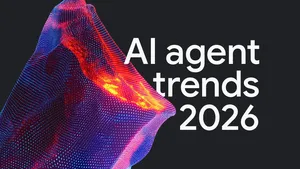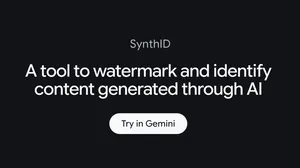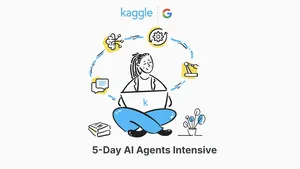AI breakthroughs are transforming industries, from healthcare to finance

Editor’s note: Today, Ruth Porat addressed attendees at the Jackson Hole Economic Policy Symposium. In her remarks, she illustrated the transformative potential of AI — not only for central bankers and financial institutions, but for entire economies. Below is an edited transcription of her remarks.
At Google, one of the ways we get a window into the world’s hopes, aspirations, and areas of curiosity is through Google Trends Search data — which is public, so you can have fun exploring the data yourself. If you do, one query that spikes, every August, is Jackson Hole. When you map it out, it literally looks like a healthy EKG. In years past, I have been generating a lot of those searches for Jackson Hole — because I have been eager to know what is being discussed, and it is a great honor to be here with all of you.
The breakthrough search term in the past few years — one more popular than this conference or even the Federal Reserve — has been AI.
What is interesting about the data is the changing nature of the sentiment behind the queries. Only two years ago, many searches focused on the potential downside (“will AI replace…”). Now people are focusing on the upside opportunities — more searches asking, “How can I?” How can I capture it, use it, benefit from it? (Interestingly, one of the common searches is: “Can AI cure cancer?” — so hold that thought.)
Today, I will address the opportunities we are seeing — and implementing — with AI, not only for central bankers and financial institutions, but for entire economies.
The AI opportunity
Google sees the extraordinary opportunity of AI in four broad areas:
- Advance scientific breakthroughs — which are inspiring in and of themselves, can lead to new businesses and entirely new industries.
- Improve delivery of important social goods, like health care and education.
- Drive economic growth, potentially in the trillions of dollars globally in the next 10 years. Clearly economists’ estimates differ greatly, based primarily on assumptions about diffusion and the actual applications across industry. It was intriguing to see the recent Congressional Budget Office projection that if AI could boost productivity growth by 50 basis points per year compared to the CBO baseline, the long term debt to GDP ratio would reach a still-high but more manageable level.
- Finally, fortify cybersecurity.
A framework for capturing the opportunity
With a technology as profound as AI, that is moving as rapidly as AI, there is clearly downside risk as well. At Google we have been focused on where both the public and private sector can engage to fortify against the downside, including around safe and responsible use of AI, the energy implications and importantly tools to support the labor transition. All of these are needed if we collectively aim to deliver on the opportunity with AI, which I would argue is imperative.
In thinking about how to bring this to life, rather than drown you in use cases and case studies in the financial services sector, I thought instead that I would share examples within the context of a mental model, which I have found to be useful.
That model is health — which I am going with: First, because it is personal and relevant for all of us — it makes the upside of AI tangible and underscores reasons for optimism about the application of AI; and, second, because life sciences and financial services are two sectors where the upside with AI is particularly relevant due to their dense use of data, allowing AI to assemble insights that can unlock value and deliver outcomes beyond what humans can do without this assist.
For this mental model, I am going to briefly take you through some of the reasons to be optimistic about, as I foreshadowed earlier, cancer.
The unfortunate reality is that statistically speaking, 40% of the people in this room will be diagnosed with cancer. I was one of them. The odds are even higher for heart disease. Yet, with AI there is substantial reason to be optimistic. Extraordinary outcomes are becoming ordinary in three ways — and those three ways at a high level are relevant across industries, including finance:
- Advancing science, which, in other areas, is about innovation and extraordinary breakthroughs in solutions.
- Early detection, which in the case of life sciences, saves lives. In all other industries, it can help provide horizontal vision; accelerating finding the proverbial needle in the haystack, which is critical for risk management.
- Operational effectiveness — letting each of us focus where we need to be focused, and not getting buried under administrative tedium.
Advancing science: the health opportunity
My colleagues created something called AlphaFold for which they were awarded the Nobel Prize in chemistry — it has been described as the greatest contribution to drug discovery in our lifetime. Simply stated, my colleagues found a way to predict the 3D structure of all proteins known to humanity. Until recently, mapping the structure of just a single protein used to take three to four years. There are more than 200 million known proteins. At that pace, it would have taken humanity hundreds of thousands of years to map them all. With AlphaFold, this was achieved in months — it can help find cures for cancer in our lifetime, and more.
What is extraordinary about AI is the ability to let you take on problems and deliver dramatic new solutions. When my colleague Demis Hassabis was awarded the Nobel for AlphaFold, he said that the watershed moment in modern AI was that these kinds of learning systems were able to do something previously thought to be intractable.
With that in mind, the first major takeaway and the key question for every financial institution with which we work is: what is your most intractable problem?
Early detection and risk management: the health opportunity
In oncology, early detection is key to improved outcomes. Google has pioneered using AI to identify tiny clusters of cancer cells that have spread to the lymph nodes. Google developed a deep learning model trained to spot cancer on pathology slides, including cases where it might be missed when reviewed under time constraints. This cut the time it took for pathologists to review slides in half — and helps them detect small metastases with far greater accuracy.
Across industries, early detection is risk management.
In finance, you are dealing with mountains of transactional data, risk models, compliance rules, market signals. AI gives you the power to cut through the noise, detect patterns, and make smarter decisions faster.
Operational effectiveness: the health opportunity
For doctors, this means using AI to ingest vast quantities of new medical research, enabling them to focus on the idiosyncrasies of the patient to find solutions. One example in pediatric oncology: Google is working with a leading cancer center to support doctors by analyzing vast and growing research and medical breakthroughs. They then combine this with the idiosyncratic data from their patients to help identify personalized cancer treatments faster. Yes, they still go to the tumor board, where they rely on the experience of other doctors. AI is not a replacement for judgment — it is an accelerant for insight. In other areas, AI is helping to reduce the administrative burden for doctors by as much as 30% — giving them more time to spend on diagnosis and care, where they are needed most.
There is the mental model: major breakthroughs to deliver new solutions, enhanced pattern recognition for early detection, and operational effectiveness, unlocking operating leverage, which I will now marry with some specific finance case studies.
One caveat: The reality is that things do not always fit neatly into one bucket or another. For example, streamlining siloed workflows delivers operational effectiveness, and in many cases it can meaningfully enhance the customer experience.
Applying the model in finance
Risk management
Starting with risk management, there was no shortage of lessons from the global financial crisis.
One of the greatest privileges of my career was to be seconded from Morgan Stanley to work with U.S. Treasury Secretary Hank Paulson and many of you at the Federal Reserve during that painful period. I will never forget: after working with the U.S. Treasury and the Federal Reserve on Fannie Mae and Freddie Mac, I went home on the Sunday after the Lehman bankruptcy — only to get a call to come back down to the NY Fed. We learned that AIG would be out of liquidity by Wednesday due to counterparty risk in a derivative subsidiary in the UK.
That led me to the very important lesson that I have been repeating ever since: You cannot drive a car with mud on the windshield. You cannot run any institution with mud on the windshield. You need to clear it away — which is what data and risk analytics provide.
AI and ML can be a powerful assist in “clearing the windshield.”
Consider anti-money laundering. Instead of a single flagged transaction triggering a manual investigation which consumes hours or days to analyze, AI sees patterns across the entire network in real time. With AI, you can spot a newly created business account with dozens of small deposits from across the country — each just under the $10,000 reporting threshold. It then cross-checks the business director’s name against global sanctions and media reports, flagging a hidden link to a high-risk entity. Then alerts the security team before the funds are wired offshore. One of Google’s banking clients saw three times more financial crime risk detected, 60% fewer false positives, and a 50% faster path from detection to action.
Another critical example of early detection and risk management is around cybersecurity. The bad news is that attacks on financial institutions — already a primary target — are on the rise. The good news is the tools exist to counteract these threats.
At Google, cybersecurity is sacrosanct — embedded deep in our culture. Google was built from the ground up with an intense paranoia about anyone breaching personal data, and with a maniacal focus around every element of fortification, including what’s called “zero trust,” mandating strict identity verification and authorization for every access request, regardless of whether the user or device is inside or outside the network. That is what we use with our enterprise partners — public and private sector.
Yet we know that we have to keep upping our game, because the bad guys do. That is why we continue to invest massively in cybersecurity. That is why we acquired Mandiant. Mandiant’s insights underscore the need for a layered security approach — robust multi-factor authentication, constant patching, and better internal detection capabilities. Right now, the global median “dwell time” — meaning the time to detect an incident — is 11 days. The faster an incident is detected, the less damage an attacker can inflict.
That is also why we are leveraging Google DeepMind — Google’s AI research laboratory. Recently we had a breakthrough in applying AI to security threats that shows what is possible: Google DeepMind introduced an AI agent called Big Sleep. That agent was developed to proactively hunt for unknown software vulnerabilities. We were pleased to see it find its first real-world flaw in November, proving AI can plug security holes before they are exploited.
Since then, it has uncovered multiple critical vulnerabilities, including a recent one that was known only to threat actors. Using intel from Google Threat Intelligence, Big Sleep predicted the flaw was about to be weaponized — and shut it down. This is believed to be the first time AI has directly stopped a live exploit in the wild. Google is now applying this breakthrough beyond Google, helping secure open-source software across the internet.
Google will continue to push the frontier, because this threat is growing, and profound — both financial and reputational. I firmly believe that AI must be applied to keep up with the growing threat horizon.
Operational effectiveness and efficiency
In operational effectiveness and efficiency, I will call out three examples:
First, AI applied to customer support is increasingly seen as the gift that keeps giving. It provides operating leverage, clearing away the most basic questions, allowing customer support professionals to focus on the more complicated issues. More important, historically, when a call came into customer support, it did not capture the nature of the queries and analyze the root cause. Here, anyone implementing an AI contact center is actually able to harvest the insights from the customer center. I was recently with one CEO who said that once the company rolled out AI in customer support, employees indicated they wanted more of it. They essentially said, “This has eliminated the drudgery. Our teams have more time to think.”
Second, one of the most powerful new tools is something Google built called NotebookLM. With NotebookLM, you can load reports, articles, videos, audio files into it — and it will ingest and analyze. You can ask it to spot trends, or pluck out details. You can have it synthesize results and deliver them to you in the form of a podcast, which you can interrupt with questions.
Third, organizations are seeing an extraordinary uplift in developer efficiency and productivity with AI and tools like coding assist, which is something Google and many others are offering. We hear this repeatedly from banks as a priority.
Innovation and growth
The final category: AI can support and accelerate growth opportunities — to add alpha.
That innovation can be in the tech stack itself, by which I mean chips, models, and applications. We are talking to a number of banks and other financial services companies about the application of TPUs within their system to enhance their trading operations.
In the applications, it can come in the solutions that allow organizations to get closer to customers — especially with agentic AI. One example my colleagues are excited about is the opportunity to address so-called HENRYs: High Earners, Not Rich Yet. Top-tier financial institutions employ tens of thousands of financial advisors who dedicate their time to knowing, understanding, and serving high-net-worth clients. However, that white glove model cannot scale to address the fastest growing wealth segment — the mass affluent and “HENRYs.” That means there is an “advice gap” and a missed opportunity to build relationships with the next generation of top clients.
This is a huge opportunity to deploy agentic AI — systems that combine the intelligence of advanced AI models with access to tools, so they can hoover in information and understand, reason, and act across complex workflows — and take actions on your behalf and under your control. This enables advisors to assemble hyper-personalized recommendations for clients, reducing human preparation time by over 60%, which, again, frees advisors to focus on building relationships.
Getting up the curve
Let me wrap up: the question I get most frequently is around where to start: “How does my team quickly get up to speed on something that is changing so quickly?” Our head of Cloud Thomas Kurian has this great phrase: if you try to let a thousand flowers bloom, you’ll end up with a thousand dead flowers. AI investment and strategy needs to be about CEO or executive curation at the top, with a bubbling up of ideas through the organization.
The first step is: We each need to get comfortable with AI, and experiment. You will immediately see that there actually has been a lot of magic done by the computer scientists and engineers, and now it’s on us to get better with the prompt, the query. With some experimentation, even this former banker was able to learn what vibecoding is, and how to do it!
Importantly, it is also about organizational design. Of the many great impressions Google has made upon me in my now more than ten years since joining it is that innovation is about more than great talent, culture and persistence — it is something that is not left to chance. There is no guessing here. As an example, a number of years ago Sundar created what is called Google Labs as a home for AI experiments, with small groups on quick sprints to develop and test new ideas which then get infused across Google. That is where NotebookLM, which I already mentioned, was born. It is just a great product. A structured approach like this – designed to fit the idiosyncrasies of an organization and its culture – can accelerate the pace of idea generation and the impact of its applications. AI represents the best of American innovation. Its development is in the top of the first inning – with the potential to drive efficiencies for a very long time and make this country and others a better, healthier place in the coming decades.
It is exciting and I could ramble on, but I will not. Thanks again for the opportunity to join you.







